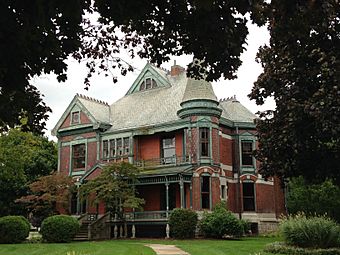Henry A. Chapin House facts for kids
|
Henry A. Chapin House
|
|
 |
|
| Location | 508 E. Main St., Niles, Michigan |
|---|---|
| Built | 1882 |
| Architect | Wheelock & Clay |
| Architectural style | Queen Anne |
| NRHP reference No. | 81000304 |
Quick facts for kids Significant dates |
|
| Added to NRHP | July 30, 1981 |
The Henry A. Chapin House, also known as Chapin Mansion, is a beautiful old house in Niles, Michigan. It's a special place because it's listed as a Michigan State Historic Site and also on the National Register of Historic Places. This means it's an important building with a lot of history!
Contents
History of the Chapin Mansion
Who Was Henry A. Chapin?
Henry A. Chapin was born in Leyden, Massachusetts in 1813. When he was just one year old, his family moved to Ohio. In 1834, when he was 21, Henry moved to Edwardsburg, Michigan, which is close to Niles. There, he started his own general store.
About ten years later, Henry teamed up with S. S. Griffin. They opened a new business in Niles that sold wool and other general goods. This business faced some tough times and didn't succeed in 1861. However, by 1864, Henry had paid off his debts and was doing well again.
The Discovery of Iron Ore
In 1865, Henry bought a large piece of land in the Upper Peninsula of Michigan, near Iron Mountain. Years later, in 1878, something amazing happened: a huge amount of iron ore was found on his property! Iron ore is a rock from which we get iron, a very important metal.
Because of this discovery, the Chapin Mine was quickly started. Henry Chapin didn't actually own or run the mine himself. Instead, he received special payments called "royalties." These were payments for the right to dig up the ore from his land. He received a lot of money from these royalties every year for the rest of his life.
Building the Mansion
With his success, Henry Chapin decided to build a grand house. He hired a famous architecture company from Chicago called Wheelock & Clay to design it. Construction on the house began in 1882. It took two years to build, and the house was finished in 1884. Henry Chapin lived in this beautiful mansion until he passed away in 1898.
The Mansion's Later Life
Many years later, in 1933, the Chapin House was given to the city of Niles. For a long time, from sometime between 1933 and 1937 until December 7, 2012, the mansion served as the Niles City Hall. This means it was where the city's government offices were located.
In May 2013, the Niles History Center took over the management of the mansion. Since then, the Chapin Mansion has been open to the public. People can now visit and explore this historic home.
Design of the Chapin House
What Does the House Look Like?
The Chapin House is a large, three-story building made of red brick. It's built in the Queen Anne style, which was popular for homes in the late 1800s. This style often includes interesting shapes and details. The house has decorations made of slate, wood, and terra cotta (a type of baked clay).
The house sits on a strong foundation made of Bedford blue stone. Its roof is a "hipped roof," which means all sides slope downwards to the walls. One of the most noticeable features is a round tower with a pointed roof, called a turret, on one corner. The house also has many porches that stick out or are set back, and bay windows that are shaped like half-hexagons.
Inside the Mansion
When you step inside, the first floor originally had a grand entrance hall. On either side of this hall were a parlor (a formal living room) and a library. There was also a stair hall, a sitting room, a dining room, a kitchen, and a pantry.
Upstairs, on the second floor, there was an upper stair hall. Around this hall were four large bedrooms. There were also separate living areas for the servants at the back of the house. The third floor was very special because it had a ballroom! This was a large room perfect for parties and dancing. Even though the house was used as Niles City Hall for over 70 years, the inside of the mansion has stayed almost exactly the same as it was when it was built.
Fort St. Joseph Museum
Exploring Local History
The Fort St. Joseph Museum is located in what used to be the carriage house of the Chapin Mansion. A carriage house was a building where horse-drawn carriages were kept. Today, this museum focuses on the history of the city of Niles.
The museum has many interesting exhibits. You can learn about Fort St. Joseph, which was built by the French in 1691 as a trading post. There are also exhibits about the Underground Railroad in southern Michigan, which was a secret network that helped enslaved people find freedom. You can also see displays about local railroads and artifacts from the Lakota people, who are Native Americans.



